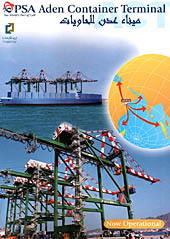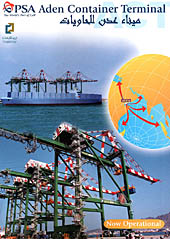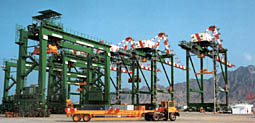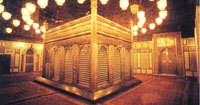
Aden Containers Terminal… Great Economic Edifice [Archives:2000/02/Business & Economy]
January 10 2000
Ridhwan Al-Saqqaf
Aden Bureau Chief
Yemen Times

Mr. Derhm Noman, chairman of the Free Zone in Aden said “The port has made good economic indications during the post-official operation as the port has received around 172 super tankers from various ports of the world. The number of containers that have unloaded since the official inauguration was over 80,000. This increasing activity can be ascribed to new international and neighboring routes entering to the containers terminal in the Free Zone in Aden. One can notice that there is an increased activity in the containers terminal in Aden since the experimental operation period in March in terms of shipping and unloading containers. There is also a focus on accuracy of dates and timetables so that work will be accelerated and services will be rendered accordingly. He also pointed to the ongoing work to finish the remaining phases of the project, i.e., the building of an additional four wharves according to the agreement signed between the General Organization of the Free Zone and Yemenivest. There are also contracts signed with different international companies for operating new marine routes through the Aden containers terminal. These companies are American, European, and East Asian, and are going to make Aden a commercial trade center in the Gulf as well as the whole Arab peninsula.

The Year 1999 has witnessed an economic development in terms of establishing some strategic projects, the most important being the container terminals project whose establishment was mainly for decreasing the costs of ships and attracting many marine lines, international investment companies to develop services and provide the most modern equipment with the least costs, especially the container carriers and oil tankers by circulation and storage of goods via transit terminals.
After signing the agreement to develop the Free Zone on March 18 1996 between the General Organization of the Free Zone and Yemenivest to build Aden International Containers and Industrial & Storage district in Caltics, Yemenivest on June 17, 1997 signed a contract with the PSA and then started working on the first stage of the international Containers Project for a period of 21 months, that is until the end of March 1999. The inauguration as well as the experimental period of operation was conducted at this phase. The project then was inaugurated officially by the President on 11.9.999.
The company has conducted the digging, filling up with earth operations and arranging in the area of the containers. It has also prepared equipment for unloading containers by using four cranes on the wharves that weigh 40 tons on 55m distance and 8 bridge cranes to distribute containers on the storage area. Besides, there are two other cranes for empty containers and there are also 22 big lorries and 45 trailers. The port was also supplied with sophisticated telecommunications and computer systems.
Project Facilities
1- Generating 14- megawatt electric power, could be increased to 25 megawatts.
2- Station for processing sanitation water and drainage system of ships waste inside the port.
3- Supplying the port with a system of supplying ships with water.
4- Extending a four-lane road leading to the project site.
5- Constructing buildings belonging to the project on an area of 10000 square meters for administration, maintenance workshop and stores for unloading containers.
The following stage of the containers port:
The ensuing stage of the second and third stage of the project will be concentrated on extending the wharves to 1650m, 6 anchors on a 60 hectares storage area for containers with a capacity of 1500000 containers a year.
Requests for Investing in the Project:
Investors’ requests for land investment till the end of October 1999 amounted to a total area of 465 hectares , all are on the basis of developing the Free Zone in Aden for the coming stages. Opportunities are still open for Yemeni Companies, Arab as well as foreign investors to invest in the Free Zone.
Factories and Establishments:
Negotiations were conducted between the General Organization of the Free Zone and CCC to establish two industrial projects for producing iron and Oxygen with a total cost of $ 25 million. They are going to be established in the Free Zone in Al-Braikah on 250,000 square ms area.
The Remaining Stages:
The second stage of the Free Zone includes extending the current tarmac of the airport and designing new courses for airplanes in the Northern side of the current tarmac. The anchorage area of ships will also be deepened to allow more big ships. There will also be a trend to develop the processing industries of raw material on the northern coast. Refinery capacity, transportation, electricity, water station will all be developed.
The third stage of the project costs $2.7 billion in terms of establishing a new building and enlarging the airport tarmac and adding a new department so as to facilitate the loading of containers. A new refinery will be built in addition to finishing the construction of a new power station to generate about 25 megawatts and building another station for water processing.
The fourth stage will cost $1.3 billion which includes improving and enlarging all the electric power and processing sanitation water in smaller Aden.
——
[archive-e:02-v:2000-y:2000-d:2000-01-10-p:./2000/iss02/b&e.htm]


